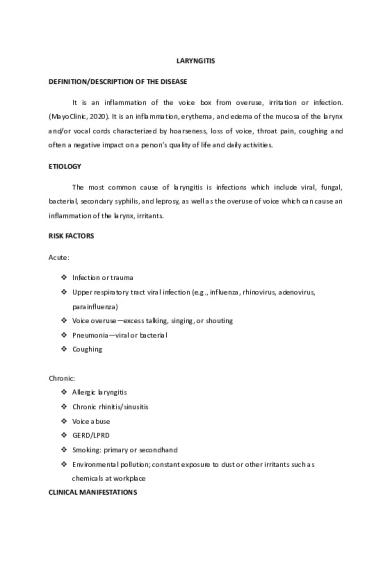Laryngitis - SDG PDF

| Title | Laryngitis - SDG |
|---|---|
| Author | Luijoy Quemquem |
| Course | Bacherlor of Science in Nursing |
| Institution | Mariano Marcos State University |
| Pages | 5 |
| File Size | 125.2 KB |
| File Type | |
| Total Downloads | 94 |
| Total Views | 169 |
Summary
SDG...
Description
LARYNGITIS DEFINITION/DESCRIPTION OF THE DISEASE It is an inflammation of the voice box from overuse, irritation or infection. (MayoClinic, 2020). It is an inflammation, erythema, and edema of the mucosa of the larynx and/or vocal cords characterized by hoarseness, loss of voice, throat pain, coughing and often a negative impact on a person’s quality of life and daily activities. ETIOLOGY The most common cause of laryngitis is infections which include viral, fungal, bacterial, secondary syphilis, and leprosy, as well as the overuse of voice which can cause an inflammation of the larynx, irritants. RISK FACTORS Acute: Infection or trauma Upper respiratory tract viral infection (e.g., influenza, rhinovirus, adenovirus, parainfluenza) Voice overuse—excess talking, singing, or shouting Pneumonia—viral or bacterial Coughing
Chronic: Allergic laryngitis Chronic rhinitis/sinusitis Voice abuse GERD/LPRD Smoking: primary or secondhand Environmental pollution; constant exposure to dust or other irritants such as chemicals at workplace CLINICAL MANIFESTATIONS
Hoarseness Weak voice or loss of voice Tickling sensation and rawness in the throat Sore and dry throat Dry cough DIAGNOSTIC PROCEDURES Laryngoscopy – the physician visually examines the vocal cords by using a light and a tiny mirror to look into the back of the throat which usually appears as redness or swelling. Stroboscopy – is a procedure that enables an assessment of the vibratory function of the vocal folds. Alterations in vocal fold vibration may result from the swelling or from vocal fold lesions that may be present. MANAGEMENT
Medical/Pharmacologic o Antibiotics – if it is a bacterial infection, antibiotic is prescribed however some studies reveal that antibiotics do not appear to be effective in treating acute laryngitis. o Corticosteroids – helps to reduce vocal cord inflammation. o Acetaminophen – to relieve pain o Voice therapy
Nursing Management o Encourage client to drink plenty of fluids. o Instruct the client to use humidifiers and menthol inhalers. o Instruct the client to gargle with warm saline solution. o Instruct client to stay away from decongestants because they dry the throat. o Encourage the client to rest his/her voice as much as possible and avoid whispering. Provide alternative means of communication during this time. o Assess respiratory status, including breath sounds, ABG, pulse oximetry level, rate and depth of respiration. o Provide instruction on the administration, dosage and side effects of medications if indicated.
o Instruct client not to perform strenuous activities because this can increase airway edema, resulting to distress. o Encourage client to eat food with thick consistency rather than liquids. o Elevate the HOB and provide supplemental humidification. o Provide comfort measures such as ice collar and humidification.
NURSING CARE PLAN ASSESSMENT Subjective Data: The client verbalized, “I am feeling uncomfortable and restlessness lately, I have a cough and sore throat which makes me have a low voice, and when I am about to lay flat in my bed, I experienced shortness of breath.” Objective Data:
Vital Signs BP: 120/80 mmHg
RR: 21 bpm
PR: 80 bpm
Body temperature: 37 degrees Celsius
Physical Assessment Presence of wheezes Harsh, brassy cough Swelling of epiglottis Orthopnea (shortness of breath) Restlessness
NURSING DIAGNOSIS Ineffective airway clearance related obstructed airway such as airway spasm as evidenced by swelling of epiglottis, presence of wheezes, restlessness and orthopnea and verbalization of “I am feeling uncomfortable and restlessness lately, I have a cough and sore throat which makes me have a low voice, and when I am about to lay flat in my bed, I experienced shortness of breath.” NURSING INFERENCE Laryngitis is caused by infections as well as the overuse of voice which causes inflammation of the larynx characterized by throat pain, coughing, loss of voice and excessive sputum which leads to ineffective airway clearance experienced by the client. NURSING GOAL After 3 to 5 days of rendering series of nursing interventions, the client will be able to: a) Maintain airway patency b) Expectorate/clear secretions readily, c) Demonstrate reduction or absence of breath sounding clear, and
d) Verbalize understanding of therapeutic management regimen. NURSING INTERVENTIONS: 1. Monitor respirations and breathsounds, noting rate and sounds. 2. Evaluate client’s cough/gag reflex, amount and type of secretions and swallowing ability. 3. Position head appropriate to condition. 4. Elevate head of bed, encourage ambulation or change client’s position every 2 hours 5.
6. 7. 8.
R: To identify indicative of respiratory distress and or accumulation of secretions. R: To determine the ability to protect own airway.
R: To open or maintain open airway in an at rest or compromised individual R: To take advantage of gravity decreasing pressure on the diaphragm and enhancing ventilation of lungs. R: To promote optimal level of function and Provide for safety measures as prevent complications or injury. indicated by individual situation, including environmental management and fall prevention. R: To maintain open airway. Instruct breathing exercises, effective coughing. Keep environment allergen free. R: To have comfortable environment. Increase fluid intake. Encourage R: Hydration can help prevent the warm liquid. Provide humidification accumulation of secretions and improve secretion clearance. if needed.
NURSING EVALUATION After 3 to 5 days of rendering series of nursing interventions, the client was able to: a) Maintain airway patency b) Expectorate/clear secretions readily, c) Demonstrate reduction or absence of breath sounding clear, and d) Verbalize understanding of therapeutic management regimen....
Similar Free PDFs
Popular Institutions
- Tinajero National High School - Annex
- Politeknik Caltex Riau
- Yokohama City University
- SGT University
- University of Al-Qadisiyah
- Divine Word College of Vigan
- Techniek College Rotterdam
- Universidade de Santiago
- Universiti Teknologi MARA Cawangan Johor Kampus Pasir Gudang
- Poltekkes Kemenkes Yogyakarta
- Baguio City National High School
- Colegio san marcos
- preparatoria uno
- Centro de Bachillerato Tecnológico Industrial y de Servicios No. 107
- Dalian Maritime University
- Quang Trung Secondary School
- Colegio Tecnológico en Informática
- Corporación Regional de Educación Superior
- Grupo CEDVA
- Dar Al Uloom University
- Centro de Estudios Preuniversitarios de la Universidad Nacional de Ingeniería
- 上智大学
- Aakash International School, Nuna Majara
- San Felipe Neri Catholic School
- Kang Chiao International School - New Taipei City
- Misamis Occidental National High School
- Institución Educativa Escuela Normal Juan Ladrilleros
- Kolehiyo ng Pantukan
- Batanes State College
- Instituto Continental
- Sekolah Menengah Kejuruan Kesehatan Kaltara (Tarakan)
- Colegio de La Inmaculada Concepcion - Cebu










